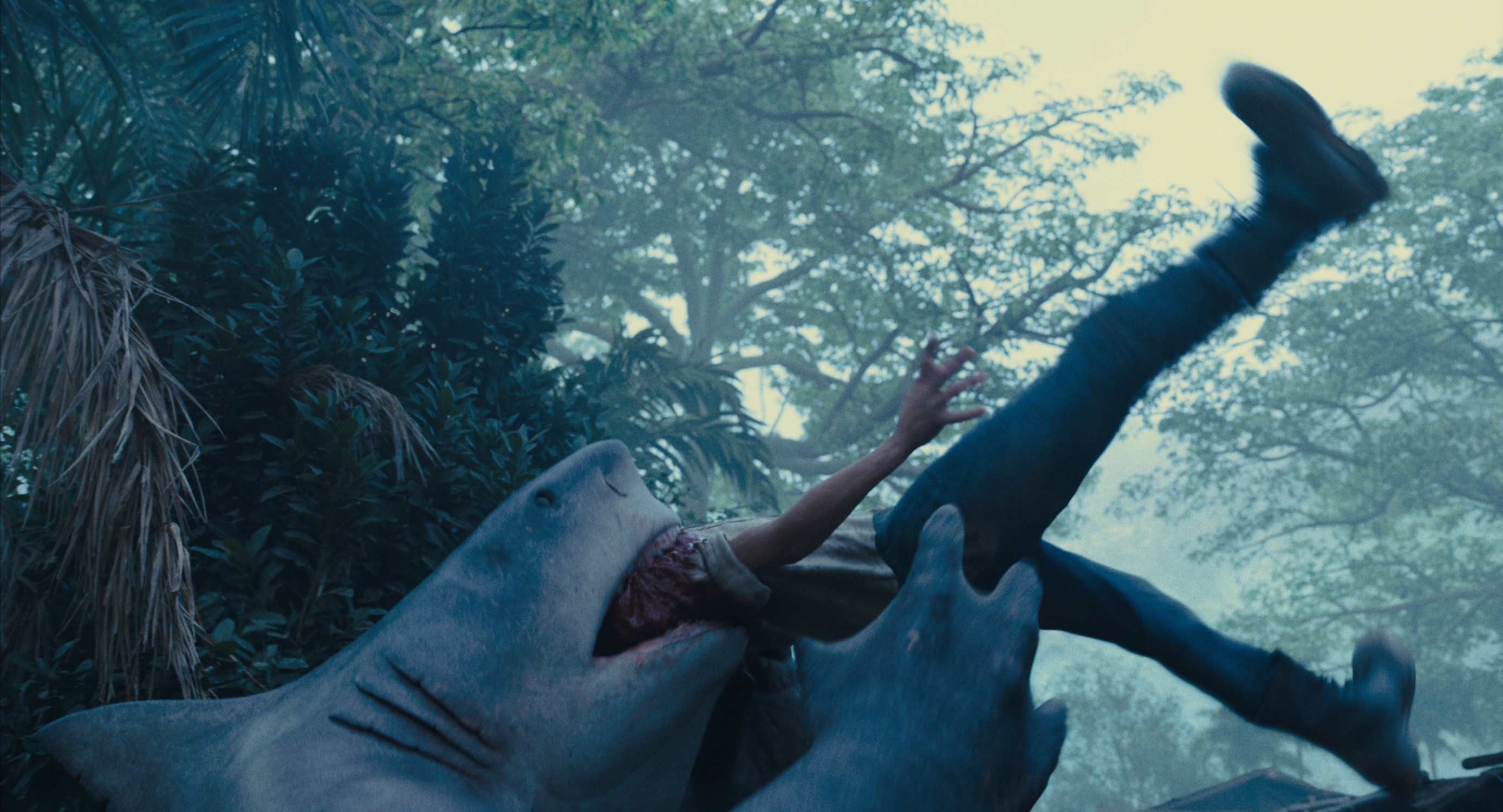King Shark in The Suicide Squad Image: Warner Bros. Pictures & DC Comics
It’s everywhere in The Suicide Squad. Long, bright arterial sprays of it; dense, running streams of the stuff; ugly, congealed masses gathered around wounds and scenes of battles past. Yes, blood is everywhere you look in the new R-rated DC antihero flick, pouring from heroes and villains alike. (And red-shirted nobodies, of course; plenty of random folks get thoroughly exsanguinated, as well.) The deluge of viscous bodily fluids leads to an unexpected takeaway—namely, that superhero films could use more of the stuff. And that maybe, just maybe, the general bloodlessness of our action-heavy, family-friendly Hollywood spectacles is a bit weird.
Sure, it’s to be expected that The Suicide Squad delivers buckets’ worth of blood you wouldn’t see in, say, Shazam! After all, director James Gunn cut his teeth in the gory world of Toxic Avenger studio Troma Entertainment, and his latest mix of the cartoonish and gritty is meant to serve as a hard-R tonic to the more sanitized and somber expressions of violence we’re used to seeing in our superhero movies. The purpose, in part, is to push the envelope, a message that’s arguably best conveyed in the film’s opening bloodbath, a switcheroo that gleefully annihilates one iteration of Task Force X, only to abruptly shift perspective to Bloodsport (Idris Elba) and company. The nihilistic celebration of comic-book excess only benefits from the inclusion of an actual blood-letting, from Blackguard’s face getting blown off to The Detachable Kid’s arms getting steadily mowed down, completely separate from his body.
But in watching that kinetic brutality, you start to be reminded that blood, as the dominant element hiding just below the surface of the skin, makes for an important aspect of onscreen violence. Namely, it becomes more real: Sure, watching an anthropomorphic shark tear a guy in half may not be exactly ripped-from-the-headlines reality, but the gushes of blood here are worlds away from, say, the toy-part plasticity of the severed heads that get repeatedly popped off in The Twilight Saga: Breaking Dawn–Part 2—or, more germane to the topic at hand, the mess-free sight of necks getting snapped in Man Of Steel and Iron Man 2. Ironically, a movie as gonzo and over-the-top in its own way as The Suicide Squad ends up feeling more real in execution than many of the theoretically more “grounded” superhero films, simply because the depiction of blood makes the violence come across as more honest, and less prosaic. In short, it makes violence what it should be—violent.
The new DC film isn’t the first to do this, of course. In recent years, films like Logan and Joker—or even the deliberately ludicrous action of Birds Of Prey and the Deadpool franchise—has delivered plenty of crimson-red liquid, albeit largely of the CGI variety. But there’s a viciousness to the sight of all that blood that feels earned—these movies don’t shy away from the inherent grisliness of their premises. And really, those four films form a useful spectrum of examples of how depicting bloody violence can serve the whole panoply of cinematic goals, from gritty, dead-serious drama to throwaway gags of puerile gruesomeness. Both styles benefit from adding blood, and both thereby introduce a healthy frisson of yuck-response realism. Compare it to the bloodless spectacle of most Marvel movies, for example, and the total lack of blood in fight scenes that get just as brutal and nasty starts to seem like a cop-out.
And honestly, isn’t it kind of weird, when you stop and think about it, that this is what distinguishes mature violence from kiddie-friendly brutality? For years now, the Motion Picture Association has used the sight of blood as one of the key ways of distinguishing family-friendly violence from the R-rated, adults-only type. (“There may be depictions of violence in a PG-13 movie,” reads the MPA’s Classification And Ratings Rules, “but generally not both realistic and extreme or persistent violence.”) Reflect on that for a moment: Watching people die horribly is somehow considered more acceptable when there isn’t a messy splatter dirtying up the place to remind you that death isn’t pretty. It’s the very definition of sanitized violence, in other words; there’s something a little disturbing about the fact that we’ve deemed someone’s neck getting snapped an acceptable degree of violence, as long as there’s no blood to accompany it. “Duh, it makes it less real, and that’s what we want for our children, to protect them,” the counterargument would go. Which is true, though maybe “Won’t someone think of the children?” isn’t the best argument for watering down cinematic violence in nearly all of these movies, regardless of tone or creative goals. (With the exception of the Shazam!s, where the youthful innocence is part of the point.)
In fact, maybe upping the blood quotient in more superhero films would serve as a helpful reminder that, just because a character wears a cape, doesn’t mean they’re as cuddly as Daniel Tiger—or as ready to be served up to your 4-year-old. We do a disservice to kids and creatives alike by pretending that violence is something other than what it is, and especially after a decade of superhero dominance in cinema, it may be time to start letting it be its own thing, which would mean letting in some blood beyond the occasional R-rated exception like The Suicide Squad. Violence in live-action film is at its most effective when it’s real; pretending we’ve all got Silly Putty for insides tremendously limits that potential.


 Keep scrolling for more great stories from A.V. Club.
Keep scrolling for more great stories from A.V. Club.